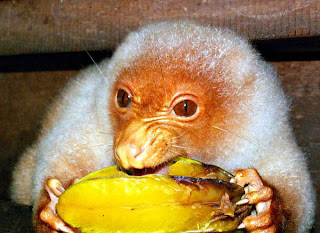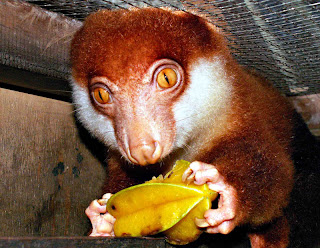Animal Wildlife | Cuscus | The cuscus is an arboreal mammal, and spends it's life almost exclusively in the trees. The cuscus is a large marsupial native to the Northern forest of Australia and the large, tropical island of Papua New Guinea. The cuscus is a subspecies of possum with the cuscus being the largest of the world's possum species.
The cuscus is known to range in size from just 15cm to more than 60cm in length, although the average sized cuscus tends to be around 45cm (18inches). The cuscus has small ears and large eyes which aid the cuscus through it's nocturnal lifestyle.
The cuscus rests in the trees during the day, sleeping in the dense foliage and awakens at night to start moving through the trees in search of food. The cuscus is an omnivorous animal but the cuscus mainly eats leaves and fruits occasionally feasting on small birds and reptiles.
The cuscus is thought to breed throughout the year rather than having a strict breeding season. The mother cuscus gives birth to between 2 and 4 baby cuscus after a gestation period of just a couple of weeks. As with all marsupials, the female cuscus has a pouch on her tummy which the new born cuscus babies crawl into and stay until they are bigger, less vulnerable and able to start feeding themselves. Typically only one of the cuscus babies will survive and emerge from the pouch after 6 or 7 months.
The cuscus has a long and very strong prehensile tail which is naked (has no fur) at the end. This allows the cuscus to be able to grip onto the tree branches more easily when the cuscus is moving from tree to tree and resting during the day. The cuscus also has long, sharp claws which help the cuscus when it is moving around in the trees. The cuscus has thick, woolly fur which can be a variety of colours including brown, tan and white.
Due to the arboreal and nocturnal lifestyle of the cuscus, the cuscus has few natural predators in it's environment. The main predators of the cuscus (besides humans) are large snakes and birds of prey which tend to pick on the more vulnerable, young cuscus. The human is the biggest predator of the cuscus as natives hunt the cuscus for both the meat of the cuscus and the thick fur of the cuscus.
When the cuscus was first discovered, scientists believed that the cuscus was a type of monkey due to the way that the cuscus moves through the trees and uses it's tail to grip onto branches. It was later discovered that the cuscus was actually most closely related to the possum.
Today the cuscus populations are declining mainly due to deforestation and therefore loss of the habitat in which the cuscus exists. More and more of the secluded forests where the cuscus dwells, is being cut down with the trees being sold to logging companies.
The cuscus is an elusive and very secretive animal that are extremely difficult to spot in the wild. It is said to be one of the most rewarding sights, if you spot a cuscus in it's natural habitat.
Tags: marine mammal veterinarian, marine mammal institute, marine mammal biologist, marine mammal regulations, mammal family tree, mammal with scales, marine mammal science, mammal class, dog mammal, cuscus grass, mammal respiration, marine mammal rehabilitation, marine mammal program, marine mammal center, land mammal, mammal behavior, mammal taxonomy, marine mammal conservation











0 Response to "Cuscus"
Post a Comment